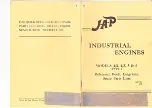
Page 300
REPAIR INSTRUCTIONS
2. Back off the valve rocker adjusting screws.
3. Loosen the No. 1 cylinder yoke adjusting
screw jam nuts for the inlet and exhaust
valves.
4. Exert moderate force on the yoke by
pressing on the rocker arm slipper end. Turn
down the yoke adjusting screw until it makes
solid contact with the outboard valve stem
tip, as sensed by a light drag on the
adjusting screw.
If the engine is equipped with an engine brake,
the exhaust yoke will be equipped with an
actuator pin adjusting screw.
Do not allow anything to press down on the
actuating pin during adjustment. The pin must be
fully extended, approximately 1/4 inch
(6.350 mm) above the top of the hollow adjusting
screw. If the pin is held down and not fully
extended, an improper adjustment and engine
failure will result.
5. Turn adjusting screw an additional 1/6 turn
(60 degrees) clockwise.
A 1/6 turn is equal to one flat on the adjusting
screw locknut.
6. Hold the yoke adjusting screw in this
position while tightening the adjusting screw
jam nut to the specified torque, 33 lb-ft
(45 N•m), using torque wrench J 24407, or
equivalent.
327
Figure 327 — Yoke Adjusting Screw and Jam Nut
7. Check yoke adjustment as follows:
a.
Insert a 0.010-inch (0.254-mm)
thickness gauge between the yoke and
valve stem, at both the inboard and
outboard locations.
b.
Exert moderate force on the yoke by
pressing on the rocker arm slipper end
as shown in Figure 328. An equal drag
should be felt on both thickness
gauges. If drag is unequal, readjust the
yoke adjusting screw, as required.
1. Valve Yoke
2. Adjusting Screw
5_106_00.bk Page 300 Friday, August 4, 2000 11:17 AM
BDC for engine manuals and specs
















































